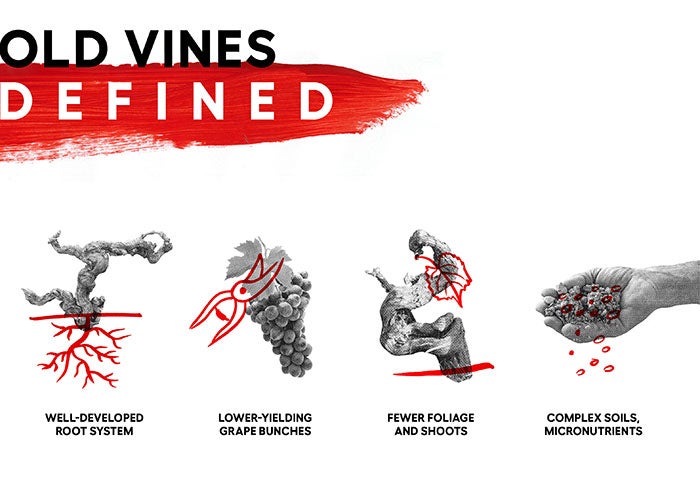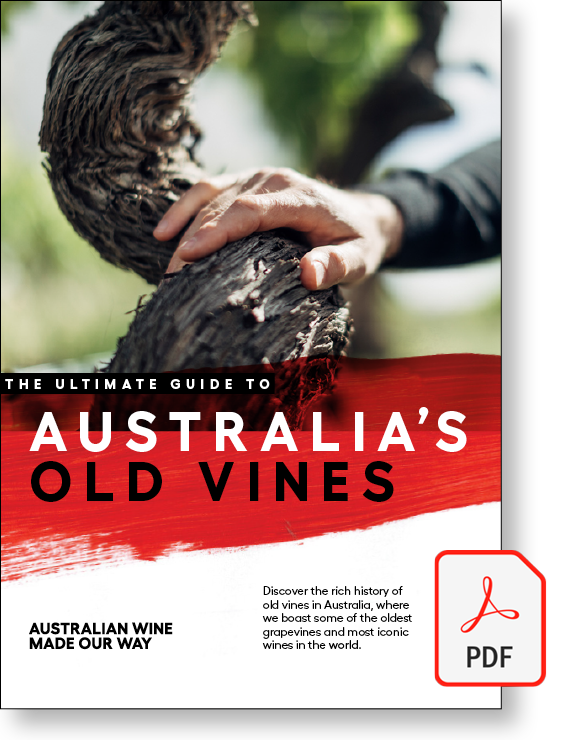Old vines in Australia date back as far as the 1840s and in the famous Barossa Valley wine region, the Kalleske family has been growing grapes for seven generations. In 1875, they planted a vineyard that’s still thriving today, making it one of the oldest in Australia. Award-winning winemaker Troy Kalleske crafts a dedicated range of wines made with these rare old vines.
So do they make better wines?
“To put it simply, yes they can – but not always,” says Troy. “I think they can make the most interesting wines.”
Like most questions in wine, this one doesn’t have a simple ‘yes’ or ‘no’ answer. But it’s one that can get people pretty passionate. Getting to the heart of it starts with understanding what ‘old vines’ actually are.
Old vines are grapevines that have been growing and producing fruit for at least several decades, and in some cases well over 100 years. These gnarled, thick-trunked vines have deep root systems that can access more nutrients from the soil, and they produce less foliage and smaller yields of grapes.
The definition of ‘old vines’ varies around the world. In Australia, the Barossa Old Vine Charter is a handy guide. It classifies old vines into four categories:
- Old vines: 35 years or older
- Survivor vines: 70 years or older
- Centenarian vines: 100 years or older
- Ancestor vines: 125 years or older. These are believed to be among the oldest-producing vines in the world.

What makes old vines so special?
Old vines don’t automatically produce better wine than young vines. There are many other factors involved, including vine quality, region, climate and winemaking techniques. And younger grapevines – anywhere from a few years old – can make brilliant wines as long as they’re good-quality vines that have been well cared for.
But precious old vines are capable of producing beautifully balanced and delicious wines with a more complex flavour profile – not to mention the fascinating stories and important history attached to them. The well-established roots of old vines can pull nutrients and water from deep below the surface, allowing them to produce more consistent fruit each year, regardless of weather conditions. And some people believe that because they produce less fruit, their grapes have more concentrated flavours.
“You can get amazing wine from five- and 10-year-old vines, but looking at 50- or 100-year-old vines, they’re unique and can make a different sort of wine,” says Troy. “The wines have that extra ‘wow’ factor, an extra dimension. They’re not necessarily bigger or richer or more full bodied, but they’ve got a nuance to them.”
Does Australia have many old vines?
Although Australia doesn’t have as much winemaking history as some countries, we do have some of the oldest continuously producing grapevines. In fact, Australia has the largest selection of old-vine material in the world, nurtured for generations.
In the early to mid-1800s, grapevine cuttings were brought to Australia from Europe and the wine community started to take shape. Soon after, many European vineyards were destroyed by phylloxera, a tiny aphid-like insect, and had to be replanted.
Phylloxera has also affected some Australian vineyards, but thanks to strict quarantine measures and the remoteness of some regions, many vineyards have been protected. As a result, Australia has some of the world’s oldest vines, including Shiraz, Mourvèdre (Mataro), Grenache, Cabernet Sauvignon, Marsanne and Semillon.
Australia’s old vines are concentrated in South Australia – including in the Barossa Valley, Eden Valley, McLaren Vale and Clare Valley – and Victoria, especially Rutherglen, Goulburn Valley and the Grampians. You’ll also find some of the world’s oldest Shiraz and Semillon in the historic Hunter Valley in New South Wales, and a variety of old vines in Western Australia’s Swan Valley.
The bottom line: if a bottle of wine says it’s been made from old vines, that can mean it’s a high-quality wine, but it’s not a guarantee. Age alone won’t turn a poor-quality vine into a great one. Old vines are allowed to grow old because they produce great fruit. They’ve been producing delicious, consistent grapes for years, and so they live on. Try a bottle of old-vine Australian wine for yourself and see if you can taste the difference.
Want to know more?
Download ‘The ultimate guide to Australia’s old vines’ to learn more about these rare grapevines and the role they play in Australia’s diverse wine scene.






